 When there's a killer on the loose you'd better sleep with one eye open. 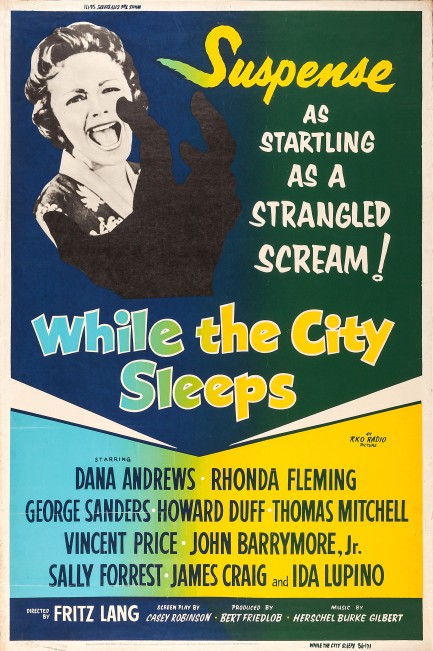
This poster for While the City Sleeps doesn't impress with masterly art the way so many vintage promos do, but its simplicity is, in an oblique sort of way, we think, meant to echo tabloid covers from the era. RKO made a special poster in collaboration with Confidential magazine, which you'll see below. The movie's plot is pure tabloid fodder. A serial killer has slain women in New York City, leaving the cryptic message “Ask mother,” written on the walls of one murder scene. Vincent Price, owner of Kyne News Service, part of a media empire comprising ten newspapers, a wire service, and other interests, offers the position of executive director to three employees in order to draw them into cutthroat competition with each other. Soon it becomes clear that finding the identity of the “lipstick killer” is the winning move. Intrigue and subterfuge take over the office. Everyone gets involved, from senior editors to stringers to gossip columnist Ida Lupino, but the killer is too clever to be caught.
At least until intrepid Pulitzer Prize winning television reporter Dana Andrews airs a scornful and taunting broadcast, deliberately setting up his own fiancée as bait. He doesn't even ask her permission. Well, he does, but only after arranging to publish their engagement announcement in the New York Sentinel right next to a story about the killer. Reckless? Yes. Presumptuous? For sure. There are intertwined plotlines here, but Andrews using his true love as a lure was the most interesting aspect for us. He isn't the only heel on display. The movie is ostensibly about a serial killer, but is really a framework for exposing backbiting and cynical ambition in the big city. Director Fritz Lang, in what was his penultimate U.S. film, explores the cruel banality of what, these days, some call “hustle culture,” and brings the production to a conclusion that's, in the words of Thomas Mitchell's character, “Neat, but nasty.” Our words are: a mandatory watch. While the City Sleeps had a special world premiere today in 1956. 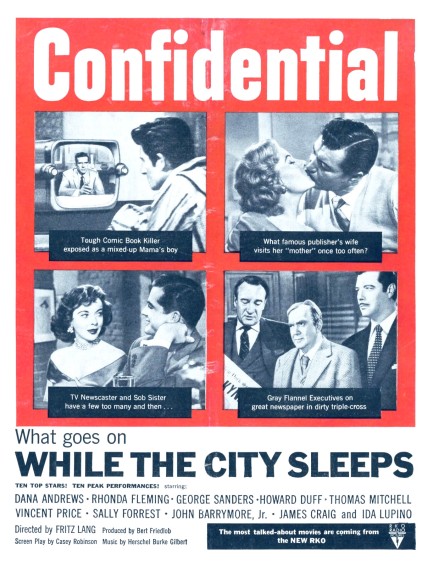 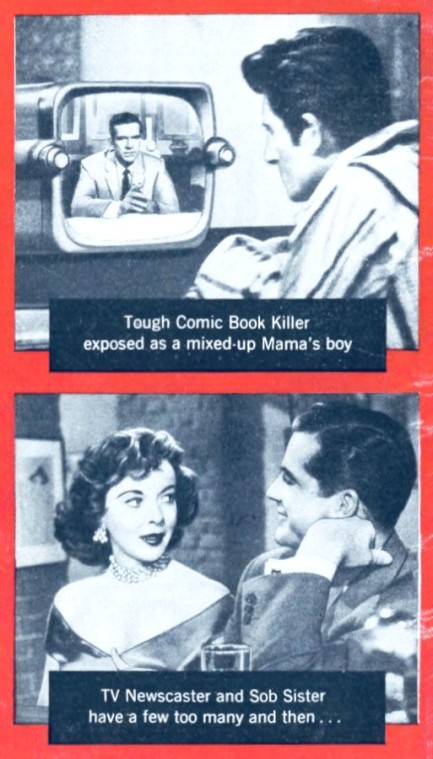 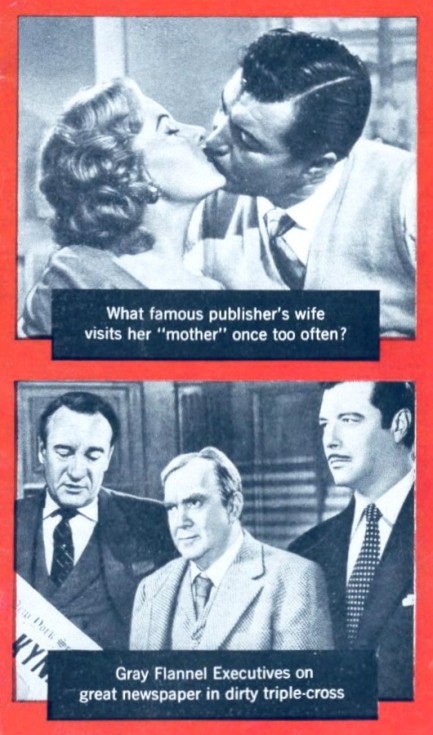 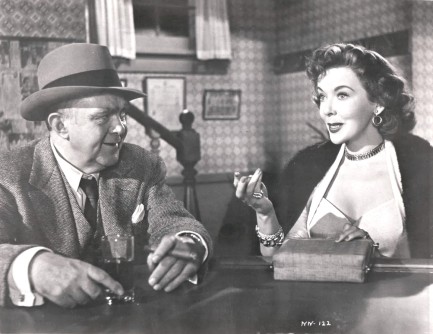 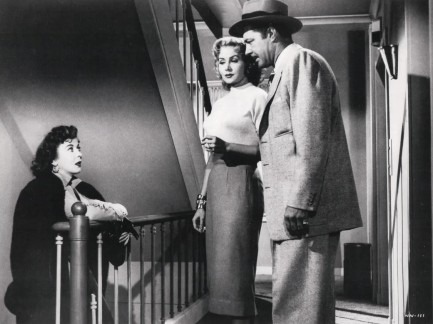 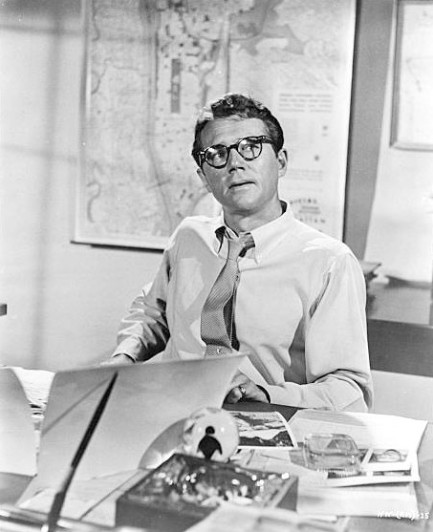 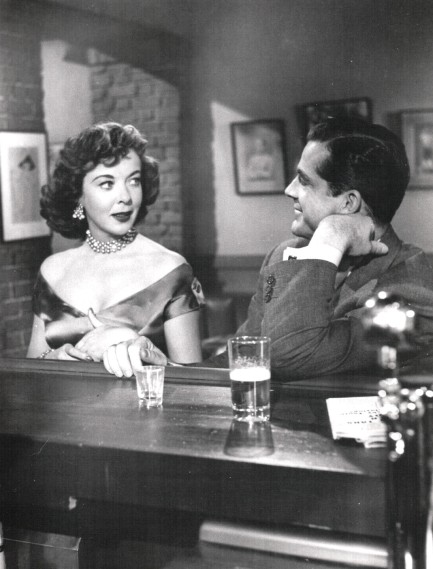  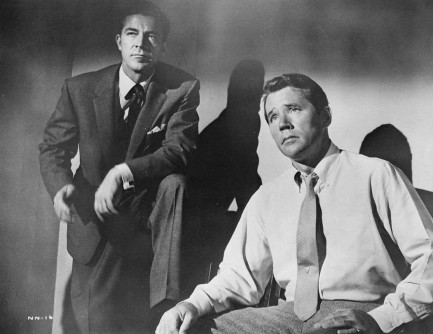 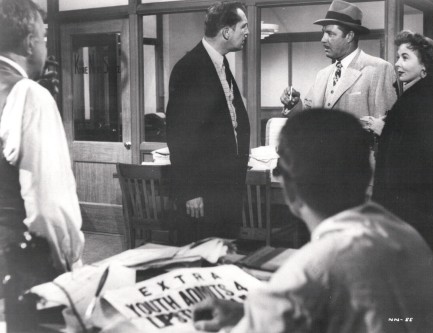 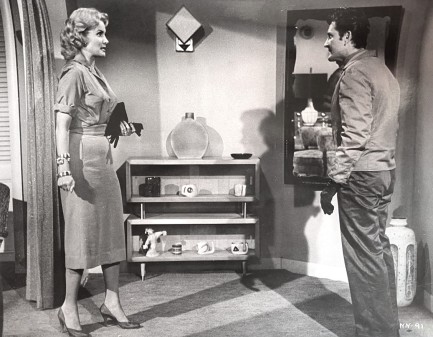 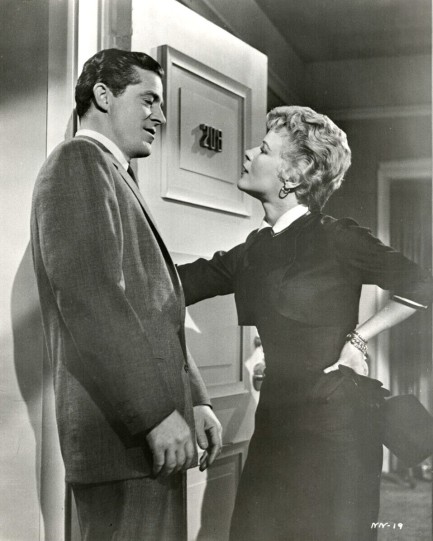 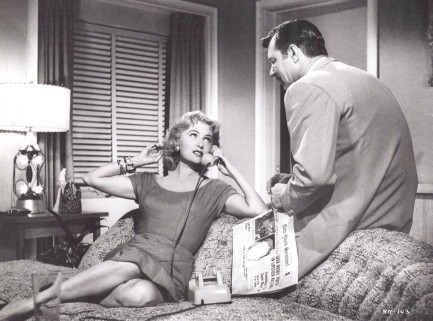 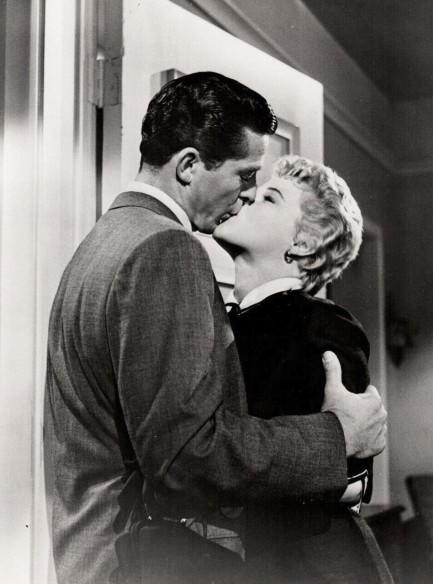 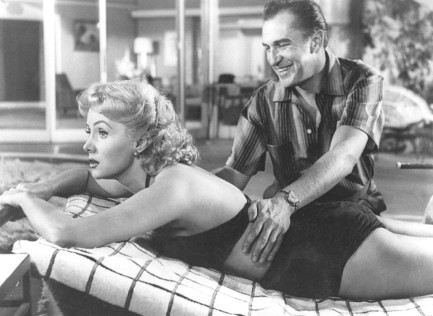 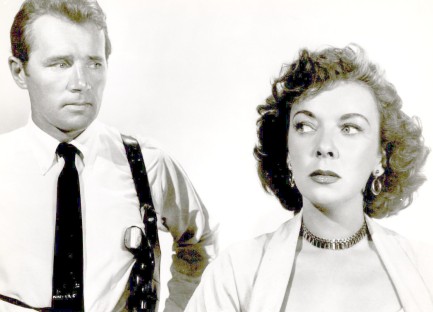 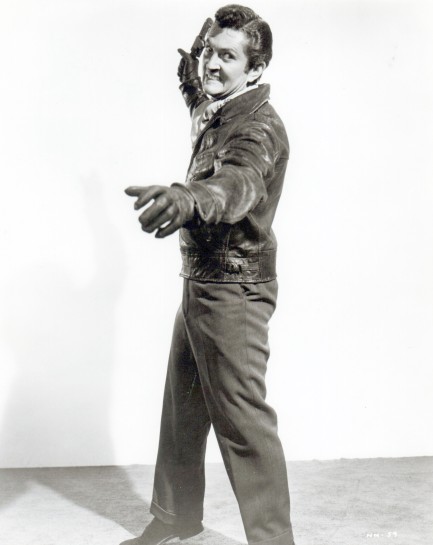 Edit: Vintage movies are excellent windows into bygone customs and practices. There's a great moment in this one. Rhonda Fleming and James Craig are chatting in her apartment late one night when the doorbell unexpectedly buzzes. They look at each other confused for a second, then Fleming says, “It's probably the drugstore. That was the last bottle of Scotch.” Edit: Vintage movies are excellent windows into bygone customs and practices. There's a great moment in this one. Rhonda Fleming and James Craig are chatting in her apartment late one night when the doorbell unexpectedly buzzes. They look at each other confused for a second, then Fleming says, “It's probably the drugstore. That was the last bottle of Scotch.”
You know, there were a lot of things wrong with the mid-century era. But there were a few things right too. Getting the all-night drugstore to deliver booze has to be one of the most right things we've ever heard of, so we give thanks to While the City Drinks—er Sleeps—for clueing us in, and suggest you call your congressional rep immediately and ask for a law allowing pharmacies to deliver alcohol. If not for yourself, do it for the children.
 Everything out there wants to kill you—including the people. 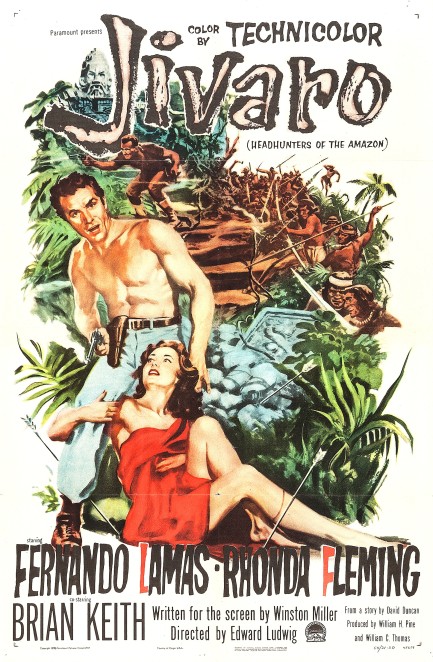
We've shown you many magazines and books on the subject of headhunters (check here and here for our absolute favorites). Mid-century interest in the subject made its way to the silver screen more than once, in this case with Jivaro, which premiered today in 1954. The title references hunter-gatherer cultures centered in the northwestern Amazon rainforest across Ecuador and Peru who shrank human heads for ceremonial reasons. The movie was a 3-D production, a fact that becomes apparent as pottery, chairs, spears, and occasional flaming arrows fly toward the camera, and it was shot in Technicolor. For those reasons, we wouldn't call it a b-movie exactly, but it still could have used a boost in budget.
Fernando Lamas plays a rough and tumble trader who plies the Amazon River in a rat trap boat. This is a rough gig. People are mean as hell down there. Even the local priest knows martial arts. Lamas agrees to conduct hot redhead Rhonda Fleming to meet her fiancée, who has ventured far from the nearest trading post in search of gold. She's fresh from California and has no idea her man has turned into a drunk and is canoodling with a local girl played by Rita Moreno.
Fleming's fiancée goes incommunicado, and eventually Lamas decides to trek into the forbidden Valley of the Winds (cue wind machine and sound effects) in order to find him. There isn't much upside to this quest, but something has developed between Lamas and Fleming, and if they don't know whether her fiancée is dead or alive, he'll always stand between them. Or something like that. They head into the wilds, endure struggles that will look familiar to fans of Raiders of the Lost Ark, and in due time find answers to all their questions, if perfunctorily.
For us, the movie raised new ones, such as where was the screenwriter during all this? Lost in the jungle too, we guess. But we can't say Jivaro is bad. While shot entirely in Hollywood with second unit footage from South America added to fill in the margins, it's actually somewhat convincing in its setting. And Fleming is good, though with her red hair we can't believe the Jivaro we able to miss her with so many arrows. But that's film tradition for you—even today, using better weapons, villains still have terrible aim. If you aim to watch Jivaro, we recommend drinking some firewater to make it a more entertaining diversion, and keeping your expectations in reasonable territory. 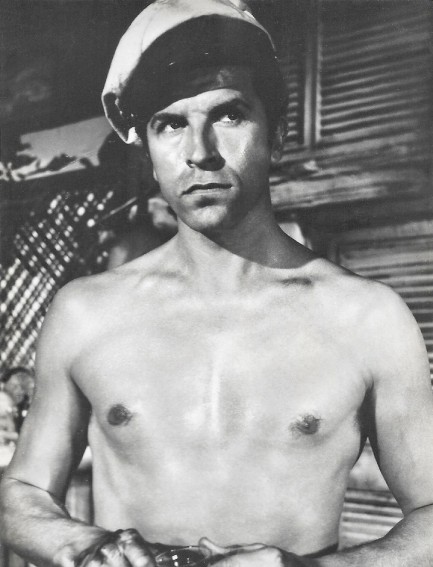 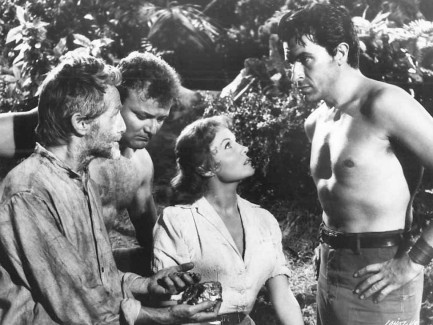 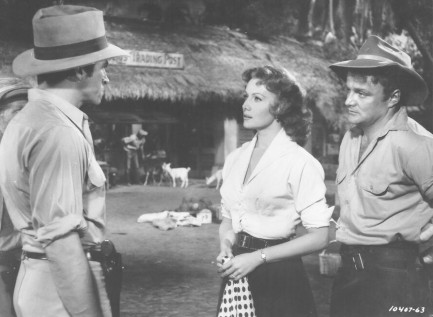 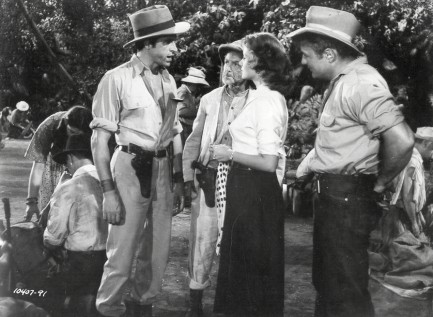 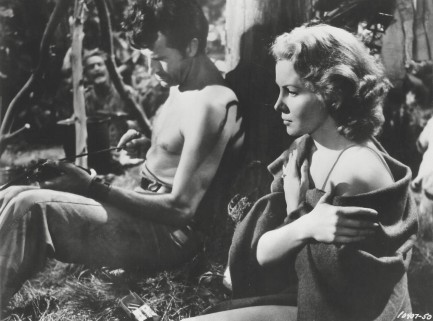 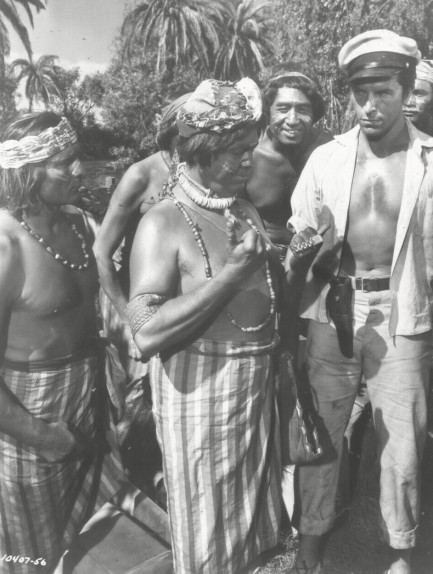 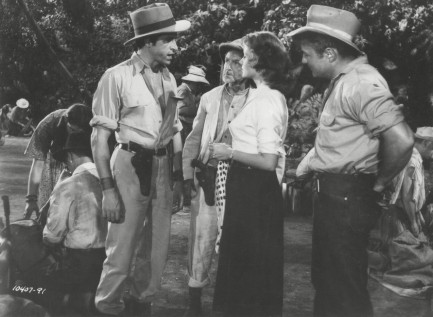 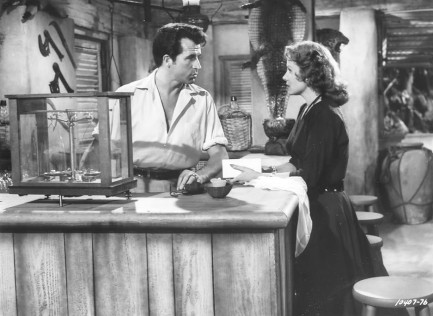 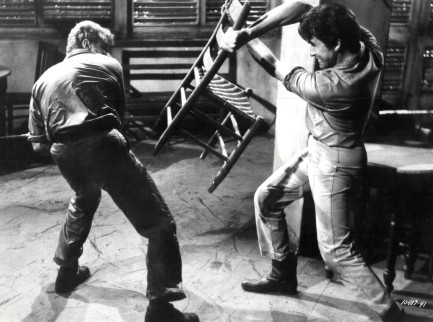 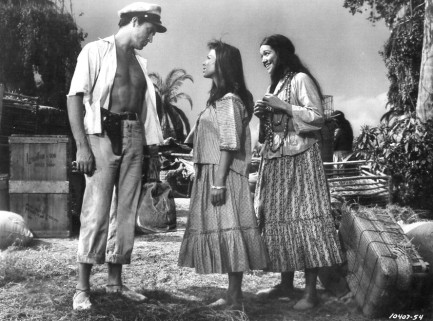 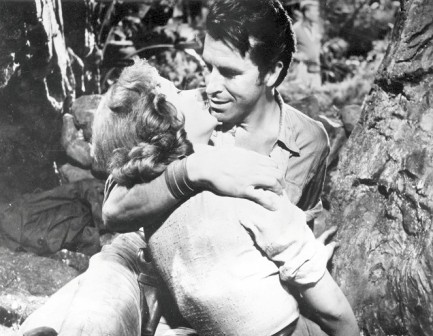 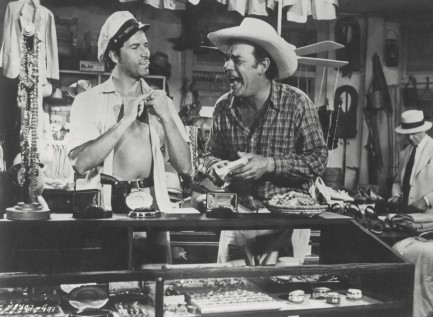 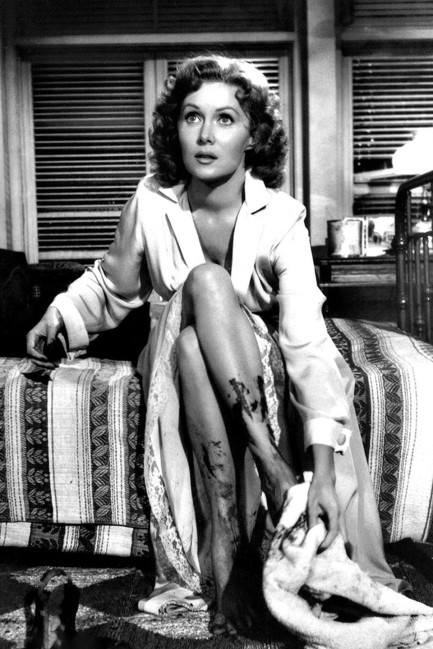 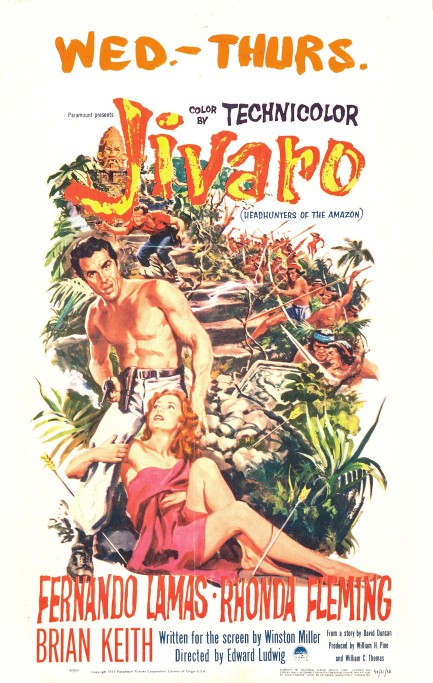
 You're asking to scrub my back? Where's your sense of adventure? 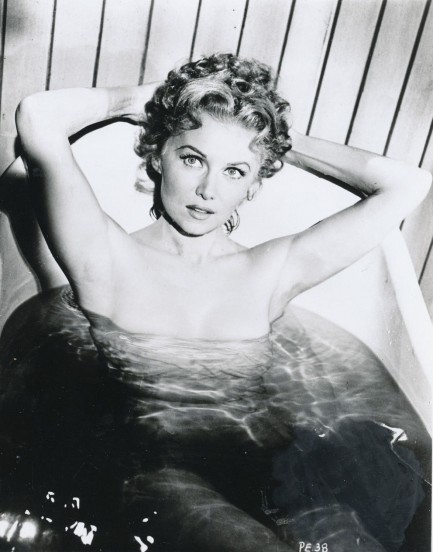
Above is a nice shot of U.S. actress Rhonda Fleming from the 1953 western Pony Express. She's looking a lot cleaner than in the image we shared back in 2010. The sequence from Pony Express is interesting because in another tub just behind a partition is the gorgeous Jan Sterling, who you see in the photo below. After Sterling has a peek over the partition, the two get out of their baths and do a little mutual hair touching. Fleming plays a classically feminine woman, while Sterling plays a short-haired tomboy. Standing there in nothing but towels, they briefly explore and discuss these differences. Subtle but deliberate bi-sexual subtext? We doubt it. Bath scenes were often inserted into Westerns to inject sex appeal. When there's something between the lines of scenes like these, only the filmmakers know for sure. In any case, it's a fun little sequence. 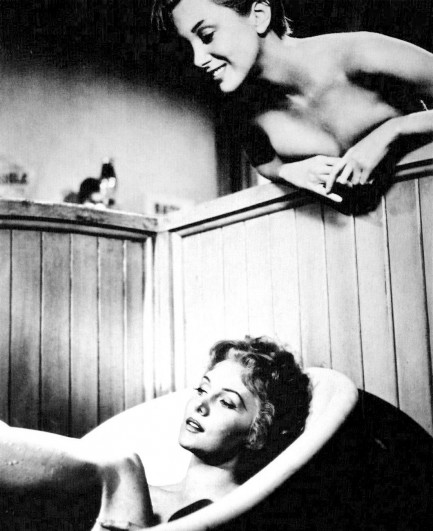
 Dick Powell faces a clear and present danger. 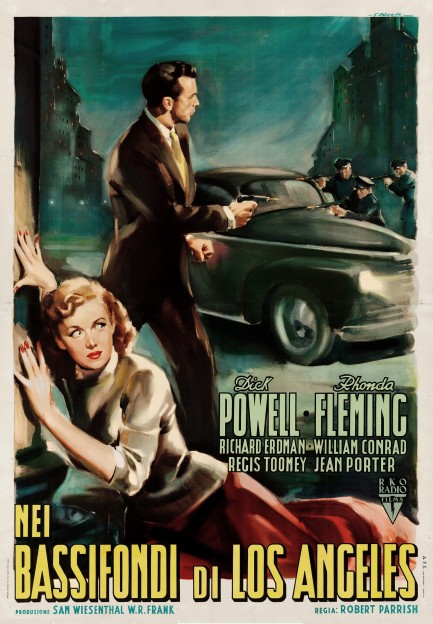
Italian artist Giorgio Olivetti painted this poster for Nei bassifondi di Los Angeles, which was made in the U.S. and better known as Cry Danger. It starred the always excellent Dick Powell, with Rhonda Fleming in support. Its Italian title means, rather uninspiringly, “in the the slums of Los Angeles,” but the poster has inspiration to spare. It eclipses the U.S. promo completely. You can see that here, as well as read about the film. Nei bassifondi di Los Angeles premiered in Italy today in 1953.
 Unless they're framed and sent to prison for life. In that case a few tears are understandable. 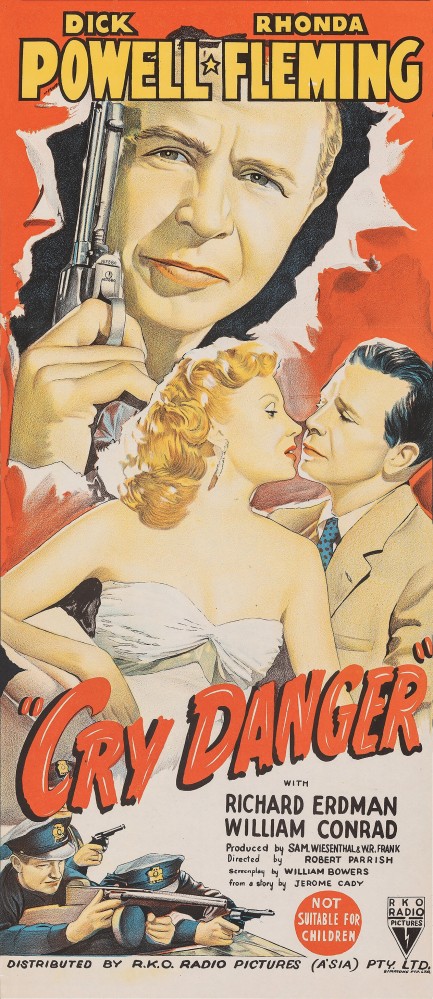
Above is a rare and vibrant Australian full bleed (i.e. borderless) promo poster from RKO Radio Pictures A/SIA for Dick Powell's classic film noir Cry Danger, released Down Under today in 1951. We wrote about this flick back in February, so if you're curious just have a look at this link.
 Let's see, I'll need one bullet for my blackmailer... one for my betrayer... a couple for his henchmen... 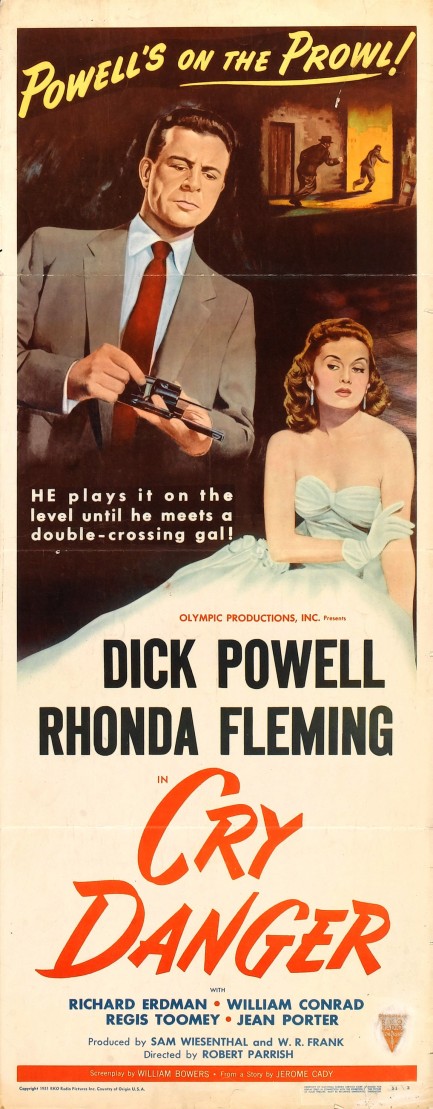
Above is a rare promo poster for the film noir Cry Danger, starring the ever reliable Dick Powell, face of such classic winners as Pitfall and Cornered. In this one he plays a criminal tossed into prison for a robbery and murder he didn't commit, but who's released when someone provides the courts with an alibi. To Powell's surprise, this rescuer isn't someone he knows, but rather an opportunist who figures to benefit when Powell goes after the hidden holdup loot. Powell, though, really didn't commit the crime. He was framed, so he goes about trying to clear his name. Since that necessarily means locating the cash, he finds himself an unwilling and unlikely asset of the police, who are following him night and day.
That's a good set-up for a movie, and with competent acting assured thanks to Powell's participation, along with that of Rhonda Fleming and William Conrad, you end up with a solid film noir that generates all the anticipated darkness and personal disaster. The movie looks good too, thanks to first time director Robert Parrish and cinematographer Joseph F. Biroc. Much of it is set in a Bunker Hill trailer park with a nice view over Los Angeles, including Chinatown. Two thumbs up on this. IMDB and AFI disagree on the premiere date, but we'll go with IMDB because it specifically mentions the premieres took place in New York City and Birmingham, Alabama. That was today in 1951 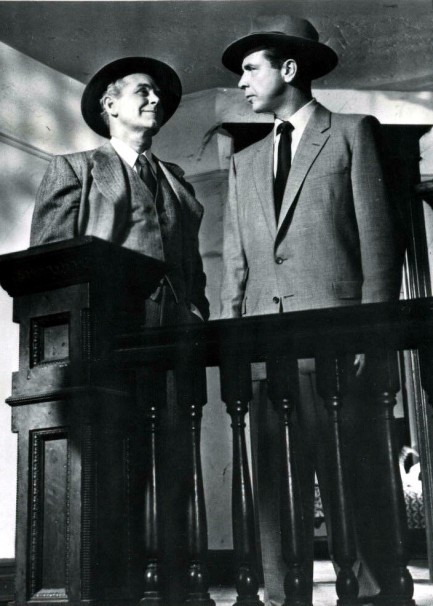 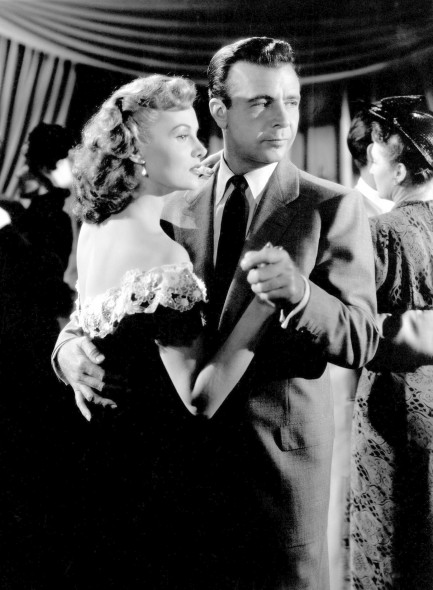 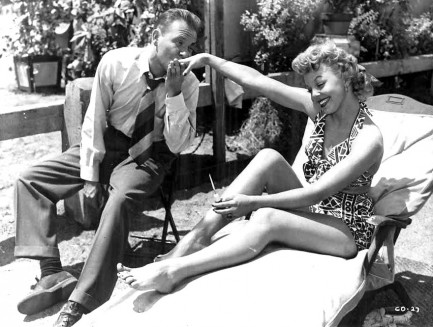 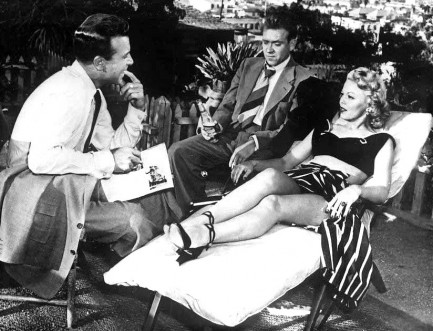 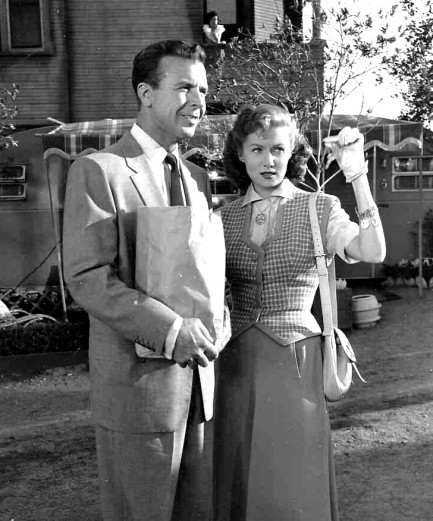 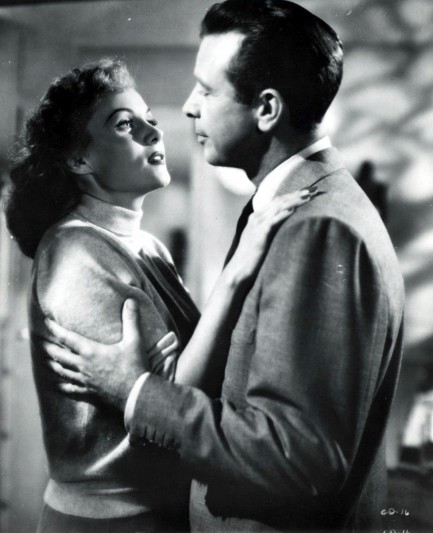 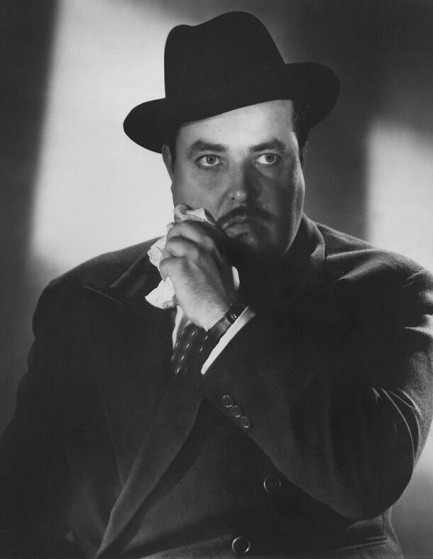 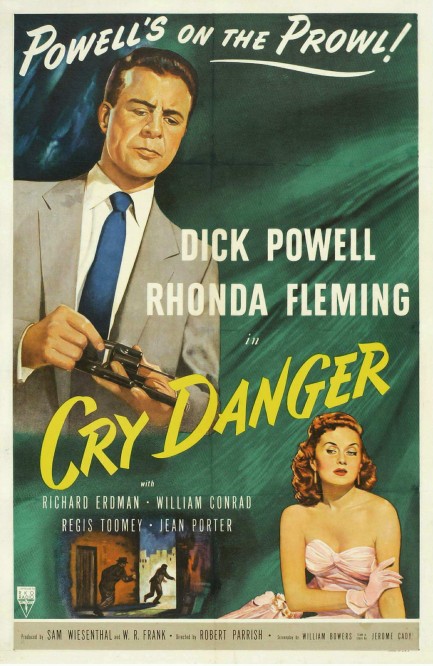
 Food and water may sustain a man, but it's revenge that really fills the belly. 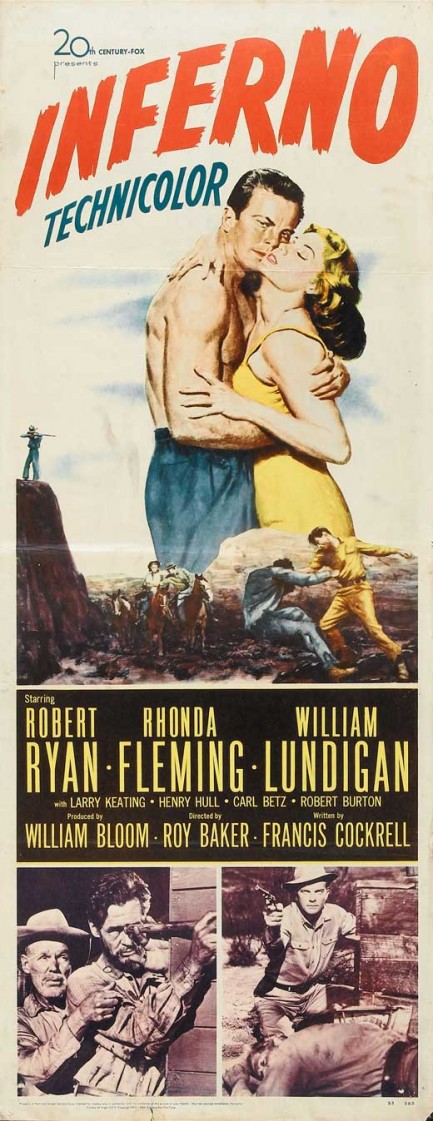
In Inferno, a boorish millionaire played by Robert Ryan breaks his leg falling off a horse during a desert vacation and is left to die by his two-timing wife and her boy toy. While the lovers cover their tracks and try to confuse the police and search parties, Ryan has to figure out a way to escape the desert. We were surprised a movie like this was made back in 1953. There have been a lot of nature horror and survival thrillers in recent years and we had no idea the genre had roots so far back. The movie is solid, though we thought Robert Ryan's voiceover was often unneeded—maybe he should have had a volleyball to talk to like Tom Hanks in Castaway. But it's a minor issue. We gather that this had a 3-D release, which of course we didn't see, but it's obvious, especially during a truly tremendous fight scene where assorted and sundry items fly at the camera. But even watching in two dimensions you still get a nice piece of entertainment, shot in crisp Technicolor, well-paced and acted, as the desert provides assorted challenges and Ryan must come up with the needed answers or die. Inferno premiered in the U.S. today in 1953. 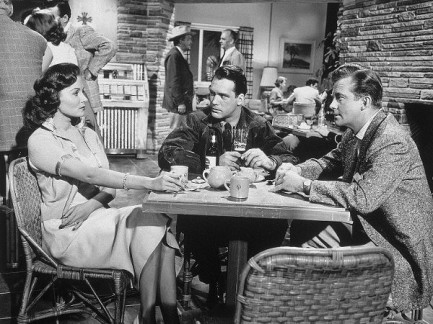 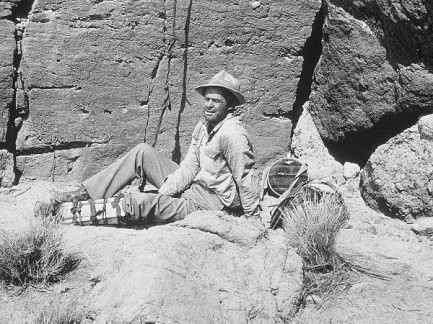 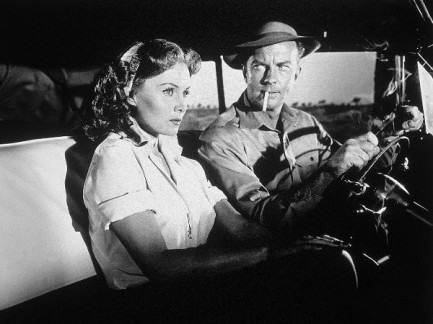 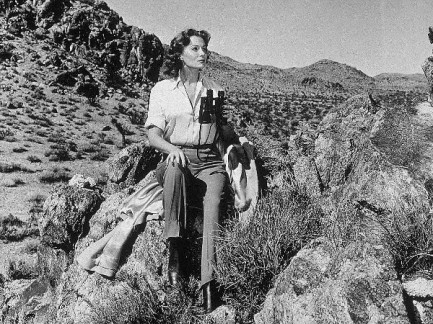
 Like Shakespeare wrote, what's past is prologue. 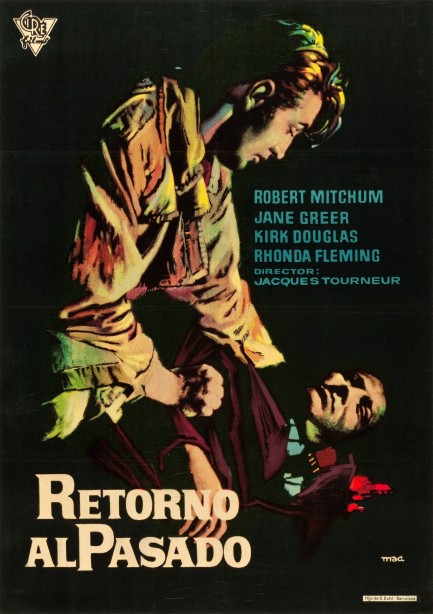
This unusual poster was made to promote the Spanish run of Retorno al pasado, a movie better known as Out of the Past. The title says it all. A man who thinks he's left his sordid past behind sees it rear its ugly head and threaten to ruin the good future he's planned for himself. Starring Robert Mitchum, Jane Greer, and Kirk Douglas, this is one of the top noir thrillers, in our opinion. Certainly it's one of the most beautifully shot, thanks to director Jacques Tourneur and cinematographer Nicholas Mesuraca. Like the poster art by Macario Gomez, the film is richly textured and lushly black, which makes for a nice sense of gathering danger, especially in the pivotal fight sequence about forty minutes in. Plus it has the always compelling Mexico connection used by many excellent noirs, as well as nice location shooting around Lake Tahoe and Reno. Highly recommended, this one. After opening in the U.S. in November 1947 it had its Spanish premiere in Madrid today in 1948.
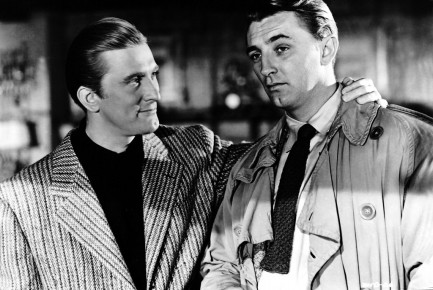 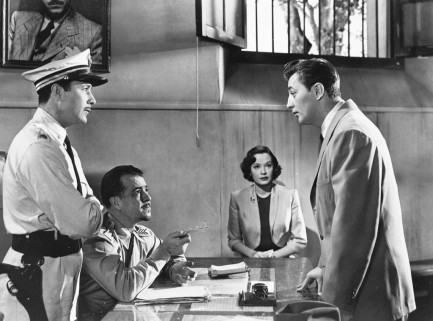 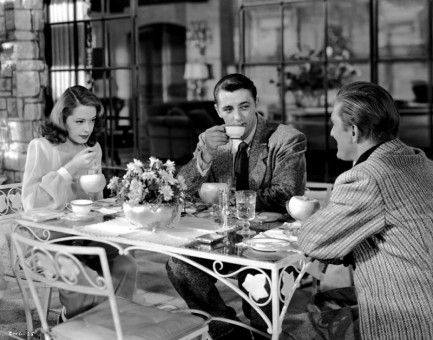 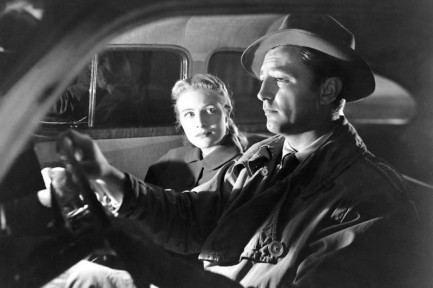 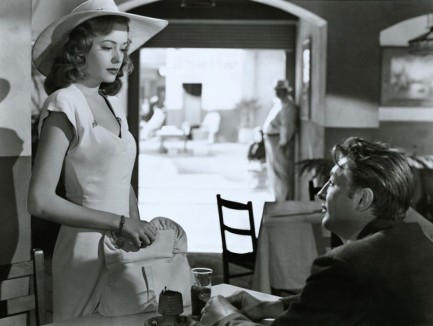 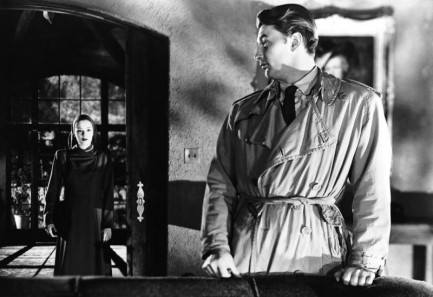  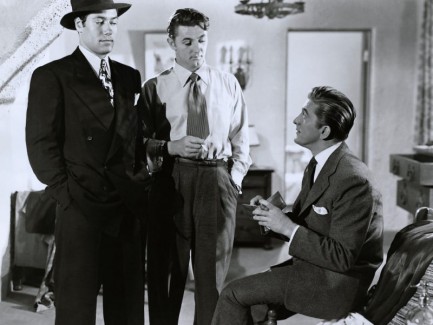
 Monroe may wobble but she won’t fall down. 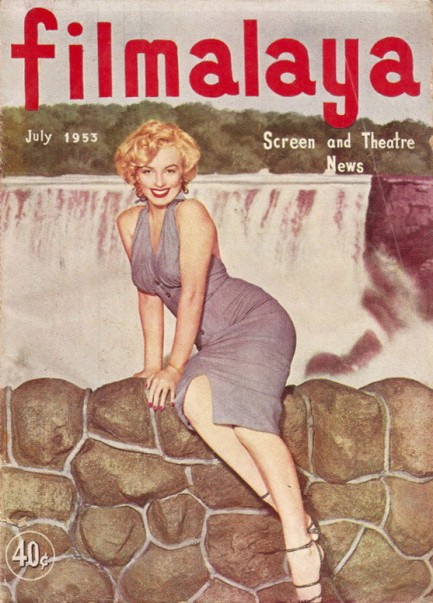
Marilyn Monroe shows up just about everywhere, and here she is yet again where we didn’t expect to see her—fronting a Malaysian film publication that appeared today in 1953. The magazine, called Filmalaya, is in English, which marks it as aimed at the British colonial community that occupied the upper stratum of society in Malaysia and Singapore. The cover photo is from a publicity series made when Monroe filmed the movie Niagara in Ontario, Canada in late 1952, and let’s just assume her perch is not as precarious as it seems and there’s a handy ledge or lawn behind her in case she goes heels up. But if she does, there are other stars in the magazine, such as Joan Collins, Betty Grable, Rhonda Fleming, Ava Gardner, and Nat King Cole. Filmalaya represents an interesting snapshot into colonial society, as in the article about Queen Elizabeth’s coronation in London, which describes the thrills and excitement in Malaysia during the event. Doubtless, the mood around the Commonwealth probably seemed festive when viewed from inside the colonial bubble, but we doubt actual Malaysians were particularly moved. Needless to say, this magazine is rare, but luckily items from Asia are often a bargain, so this cost a mere six U.S. dollars. While the inside is nothing special visually speaking, that doesn’t matter when the magazine has this great cover and is such an informative slice of history. We’ve uploaded a few of the best pages below. Enjoy. 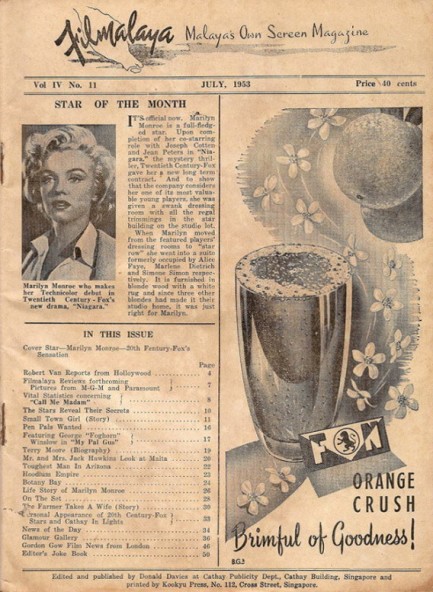 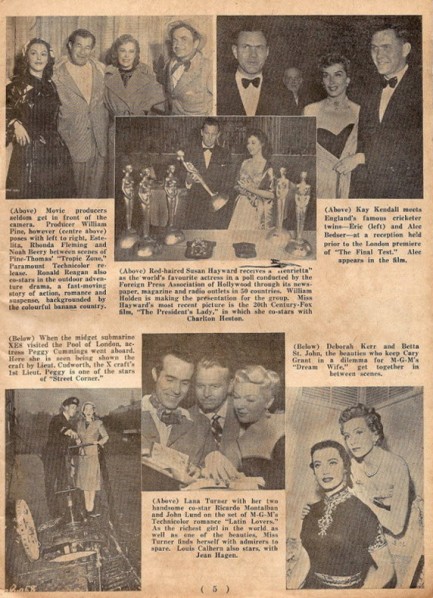 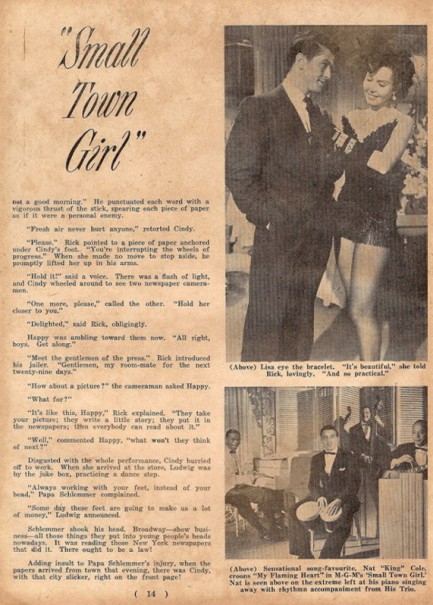 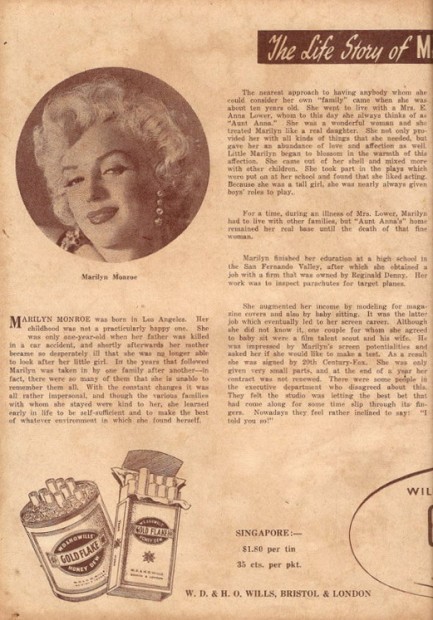 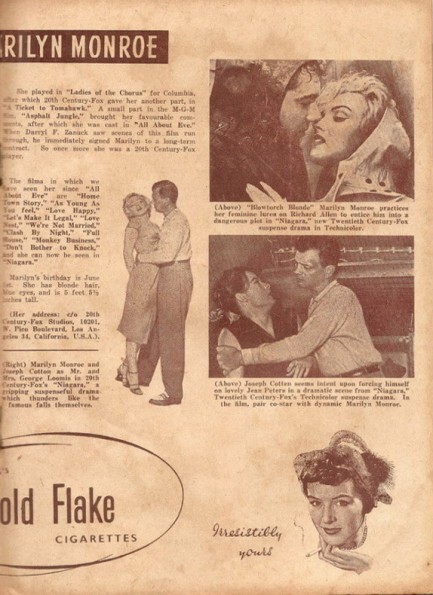 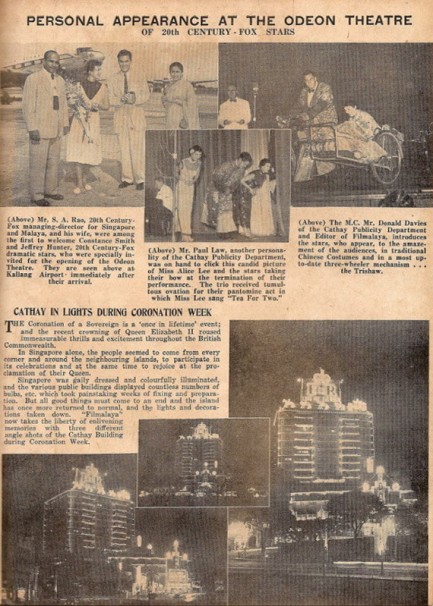 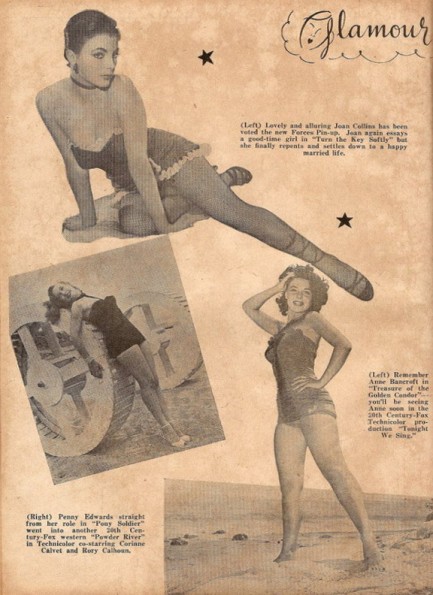 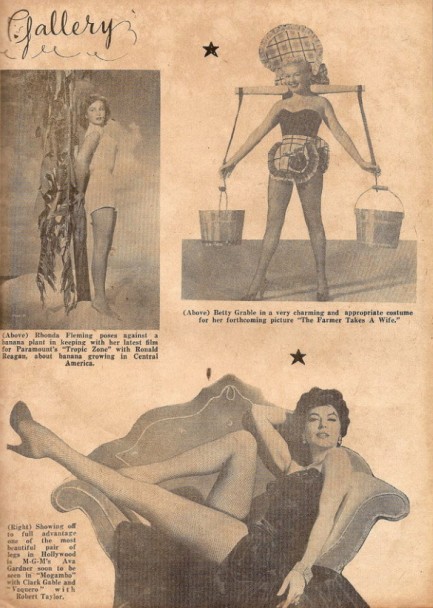
 She's coming from the red end of the spectrum. 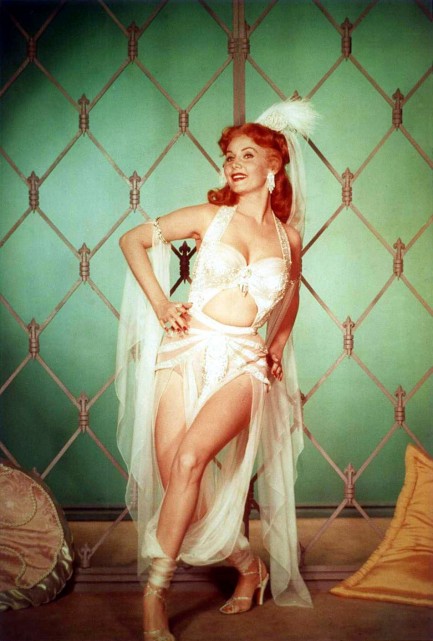
Renowned redhead Rhonda Fleming is one of the few actresses who can claim Hollywood as her home town. She was born there in 1923, and is still involved in Southern California charities. Among her many notable films were Spellbound, The Spiral Staircase, and the must-see noir Out of the Past. This great shot is undated, but it's most likely from around 1955.

|
 |

The headlines that mattered yesteryear.
2003—Hope Dies
Film legend Bob Hope dies of pneumonia two months after celebrating his 100th birthday. 1945—Churchill Given the Sack
In spite of admiring Winston Churchill as a great wartime leader, Britons elect
Clement Attlee the nation's new prime minister in a sweeping victory for the Labour Party over the Conservatives. 1952—Evita Peron Dies
Eva Duarte de Peron, aka Evita, wife of the president of the Argentine Republic, dies from cancer at age 33. Evita had brought the working classes into a position of political power never witnessed before, but was hated by the nation's powerful military class. She is lain to rest in Milan, Italy in a secret grave under a nun's name, but is eventually returned to Argentina for reburial beside her husband in 1974. 1943—Mussolini Calls It Quits
Italian dictator Benito Mussolini steps down as head of the armed forces and the government. It soon becomes clear that Il Duce did not relinquish power voluntarily, but was forced to resign after former Fascist colleagues turned against him. He is later installed by Germany as leader of the Italian Social Republic in the north of the country, but is killed by partisans in 1945.
|

|
|

It's easy. We have an uploader that makes it a snap. Use it to submit your art, text, header, and subhead. Your post can be funny, serious, or anything in between, as long as it's vintage pulp. You'll get a byline and experience the fleeting pride of free authorship. We'll edit your post for typos, but the rest is up to you. Click here to give us your best shot.

|
|


















 Edit: Vintage movies are excellent windows into bygone customs and practices. There's a great moment in this one. Rhonda Fleming and James Craig are chatting in her apartment late one night when the doorbell unexpectedly buzzes. They look at each other confused for a second, then Fleming says, “It's probably the drugstore. That was the last bottle of Scotch.”
Edit: Vintage movies are excellent windows into bygone customs and practices. There's a great moment in this one. Rhonda Fleming and James Craig are chatting in her apartment late one night when the doorbell unexpectedly buzzes. They look at each other confused for a second, then Fleming says, “It's probably the drugstore. That was the last bottle of Scotch.”

































































































































